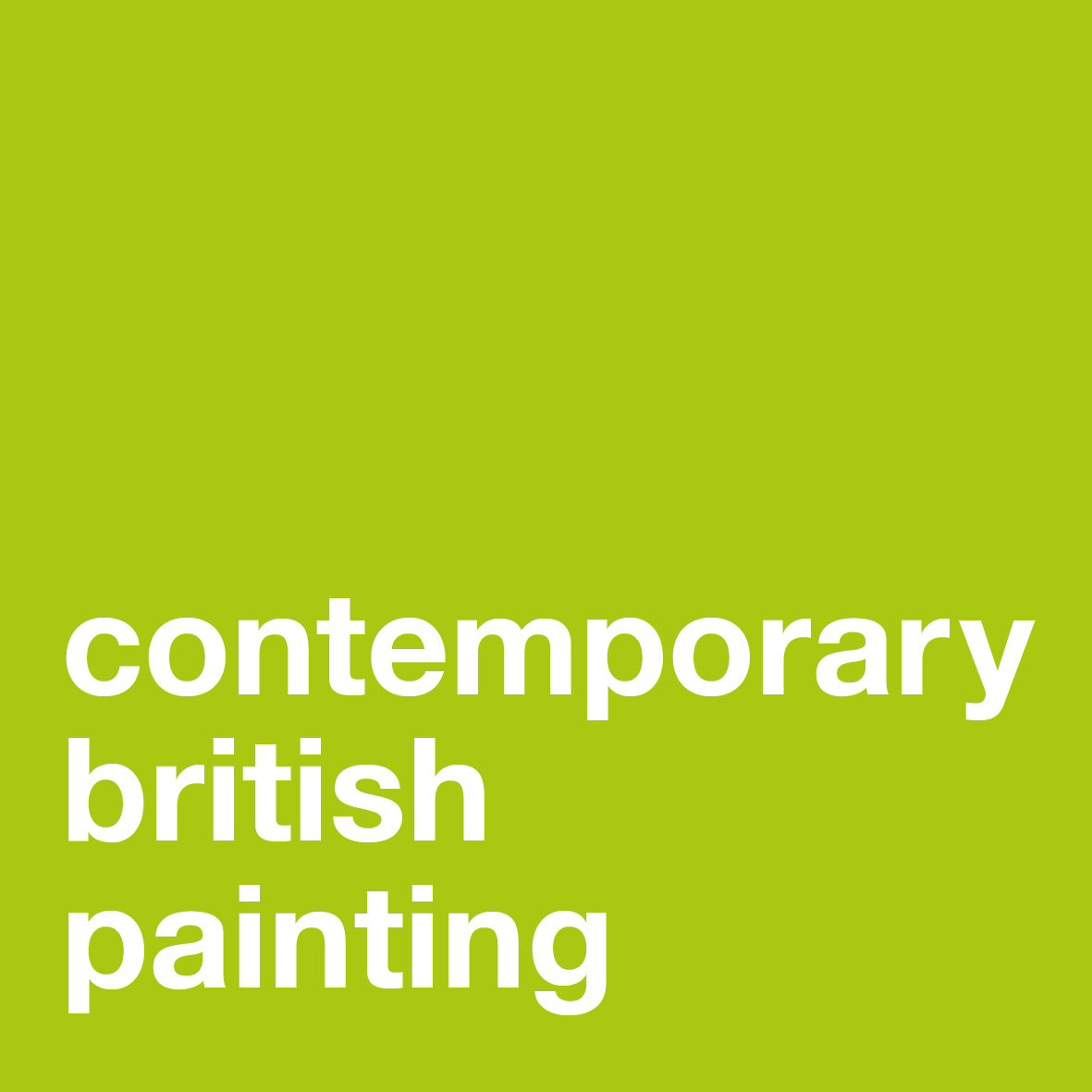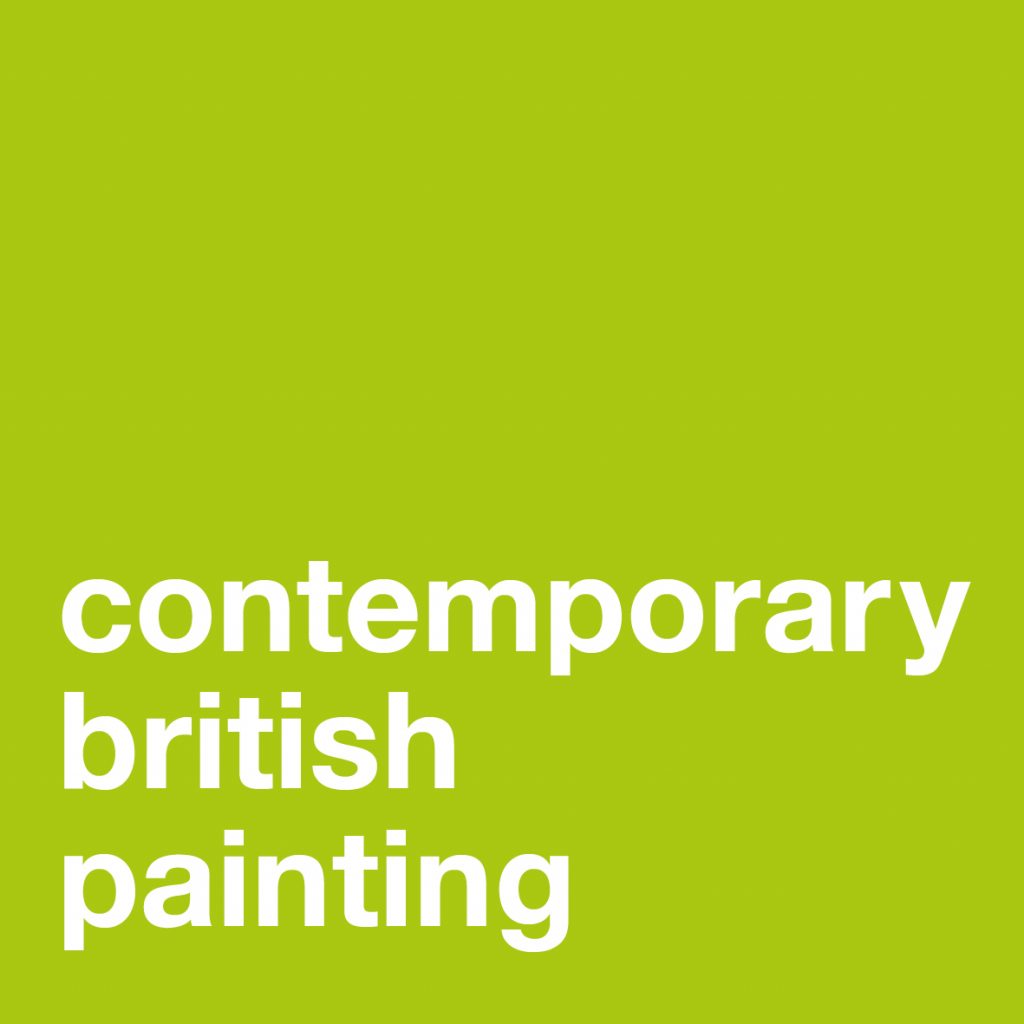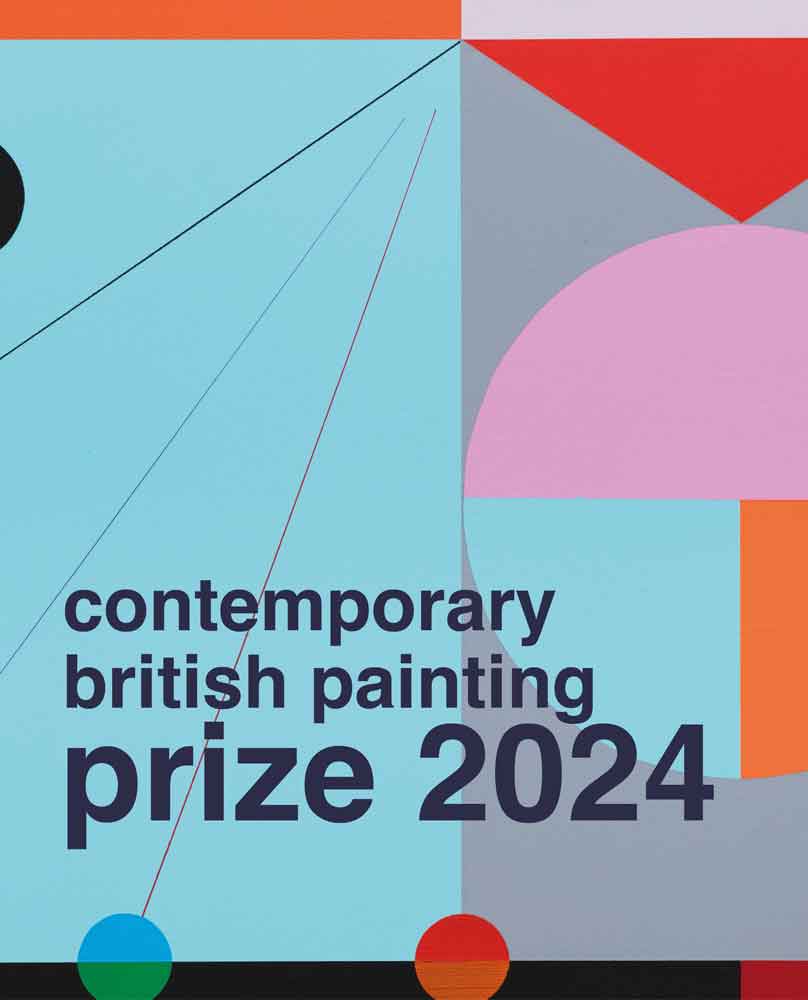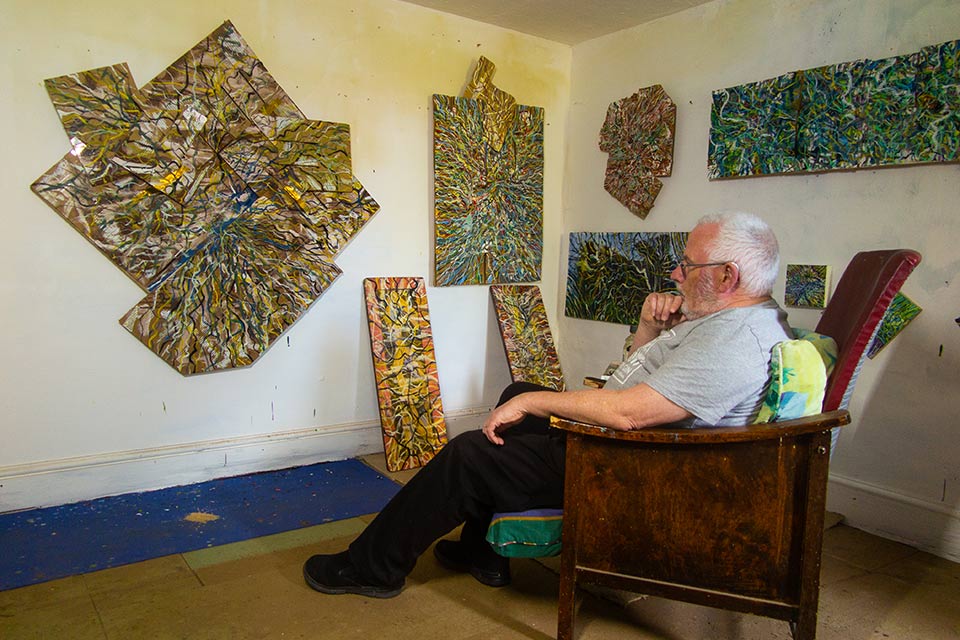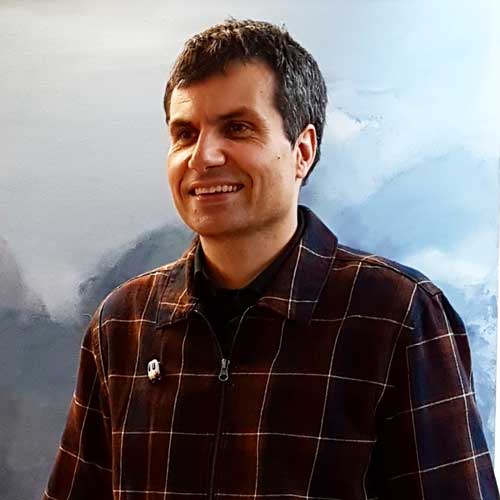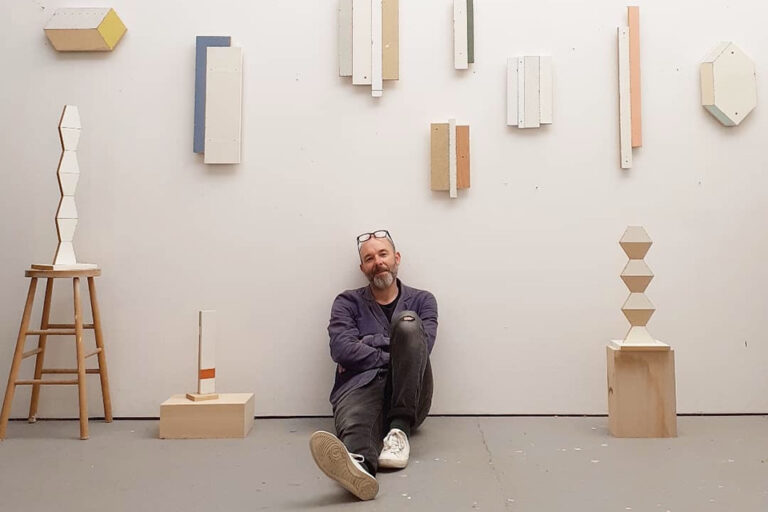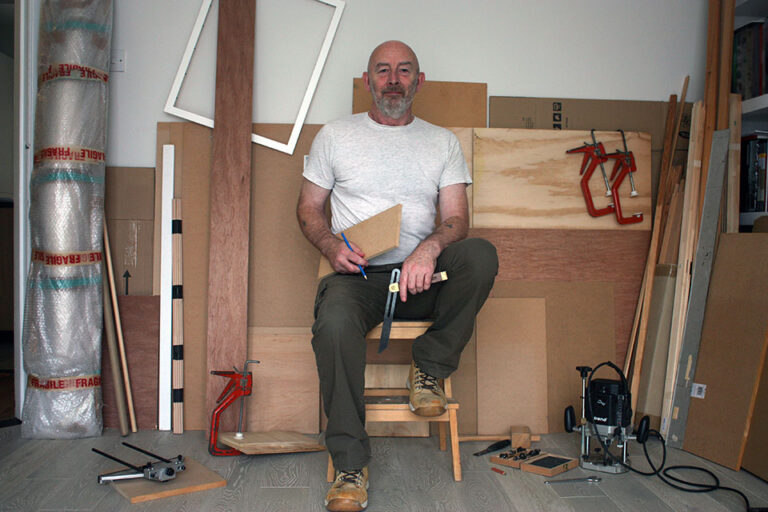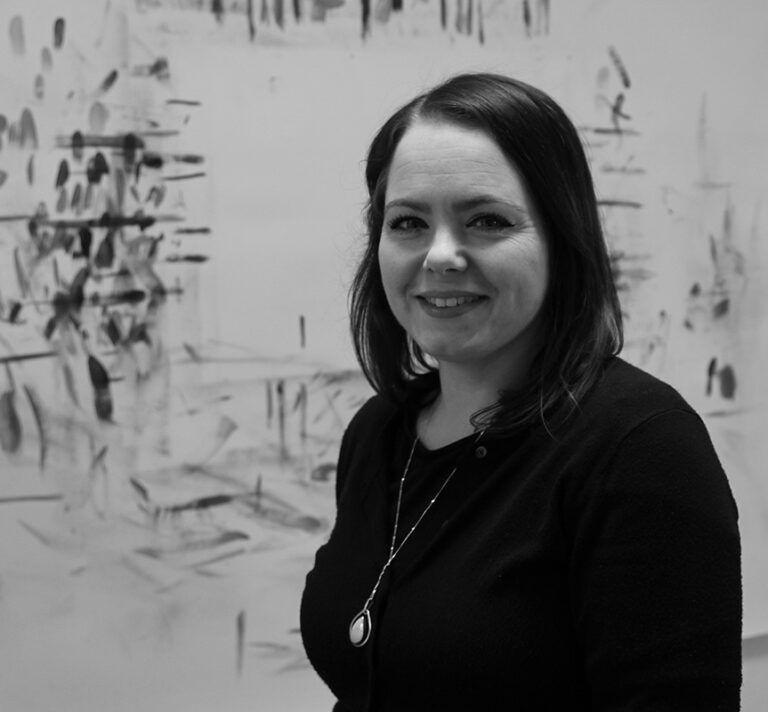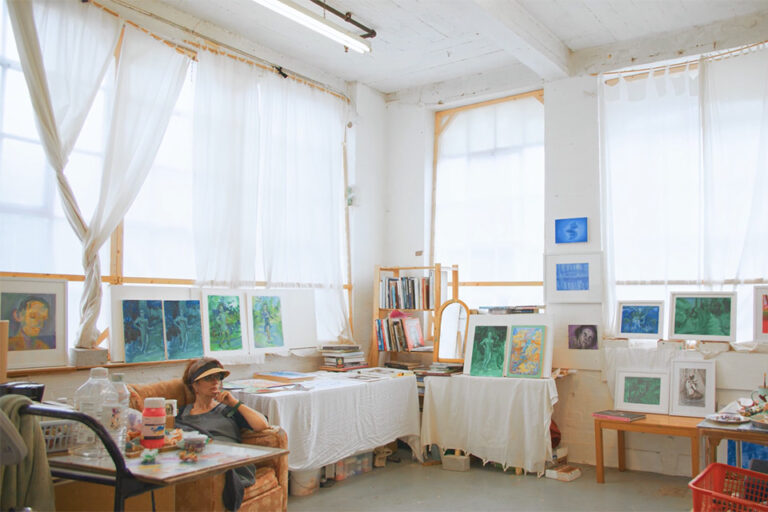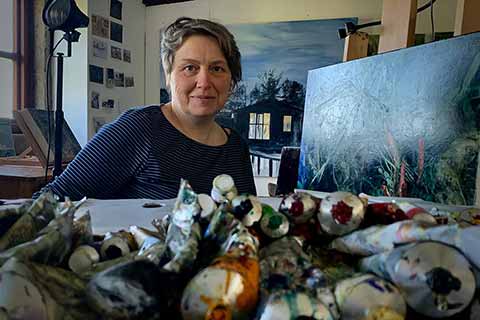David Manley: Artist of the Month
Artist of the Month October 2025:
David Manley, selected and interviewed by Paul Newman for CBP.
In this interview David Manley talks about his painting responses to landscape experience. Manley’s practice is plural, hard to categorise and pin down. Supports and media are determined by the perceived needs of each series, from ad hoc provisional assemblages as painting grounds, to modest same size panels that form a long term series in response to each town and village across Leicestershire.
David discusses three strands of his work in his studio; Hortus Fabulus, Landscapes & Memories and Ritual at the Heart of England.
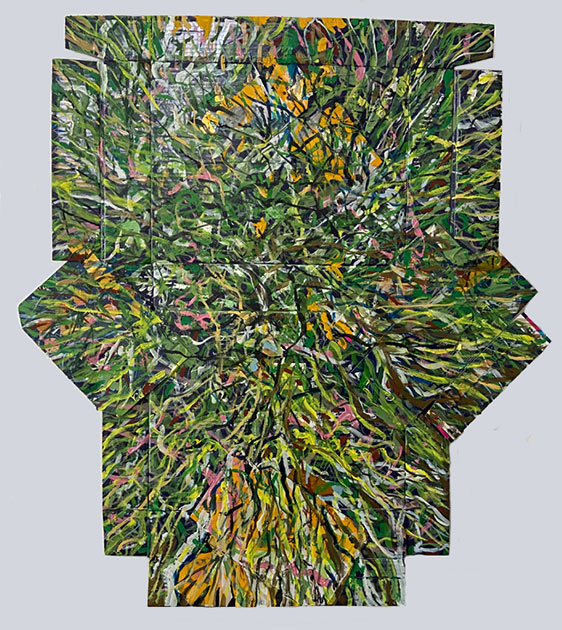
CBP: Great to meet you and really revealing to see your separate studio areas and working spaces. Your abstract paintings and constructions are in tune with your experience of the landscapes and places you’ve lived and experienced in England. How do you feel about where you are now on your artistic journey?
DM: I recall Bert Irvin being quoted in his late 60’s as saying, “I got my bus pass last year: I haven’t far to go” well I got mine some 7 years back but Bert lived on 27 years after he said that and made much of his best work in those years so I’m at least hopeful I can continue for a few more years yet. So I’m hoping to explore the places I think I already know but of course could know so much more about and to discover some I haven’t yet. I’m busy looking at and reading around coastal locations at present with a view to making more constructed pieces that reflect on our relationships with land and sea.
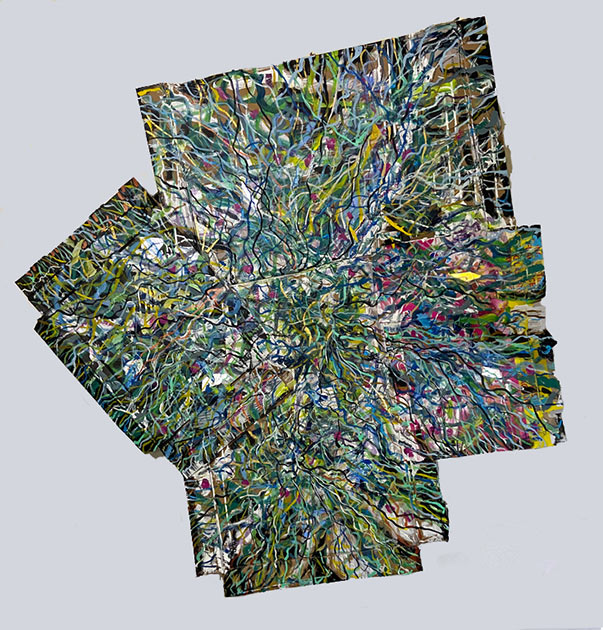
CBP: You’re working on a series painted on ad hoc cardboard assemblages that form part of a series called Hortus Fabulus. It was a delight to see the embryos put together in the garage with initial household paint applied and then taken into the basement, your main studio to be painted in more detail. They are tactile in a direct and immediate way in the application of household and artist oil-based paints on cardboard. Can you discuss the rituals and technical processes involved in preparing, priming and painting these works?
DM: Your point about the tactile quality of the work is a vital one I think. For me the mediated nature of most of our experience of painting now (through the ‘black mirror’) has encouraged me to want to bring the physicality to the fore. Whilst working through my Hortus Fabulus canvases earlier this year Ivan Smith & Anthony Shepherd invited me to show some new work at The Wireworks Project. It’s a fabulous initiative but the exhibition space is quite difficult for painting. The assemblages were the result & the location within Shining Cliff Woods in the Peak District created the impetus for the work.
The construction process I have employed is ad hoc and provisional in the extreme! The initial paint application is quick and improvised with only minimal consideration. Often the household gloss is mixed with gesso or emulsion – whatever is to hand really. Once I take them off to the studio I start thinking about what will be required to make the work lift off and reflect my ideas and intentions.
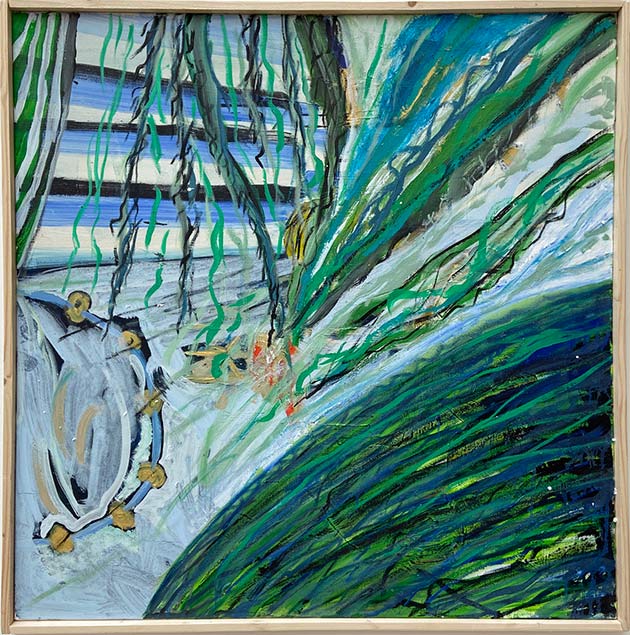
CBP: Their assemblage nature could be linked with the lineage of Synthetic Cubist collaging. The sinewy linear mark making alludes to a close-up view of tangled undergrowth and the collaging of panels are like fractures of stone or concrete ground. We discussed an affinity with artists painting from inspiration of what we observe and experience as close to the ground, like Michael Porter and Graham Sutherland’s undergrowth studies. As a painter do you have an affinity with translating landscape experience in these ways?
DM: I’d hesitate to compare myself to such distinguished company but I do like to think that much of my work over the years is related to landscape in some way. That said for me at least I’m mostly interested in my own response to being in it rather than attempting to capture something seen in it or in any way attempting mimesis. One of my first painting hero’s was Peter Lanyon so his way of interpreting landscape had a profound effect on me that still lingers. Over the years I’ve been quite taken with many others, Per Kirkeby for example and admiration for others, figurative and non-representational, who capture specific locations in profoundly personal ways such as Joan Eardley at Catterline, Mary Newcomb in East Anglia or Hitchens in Suffolk.
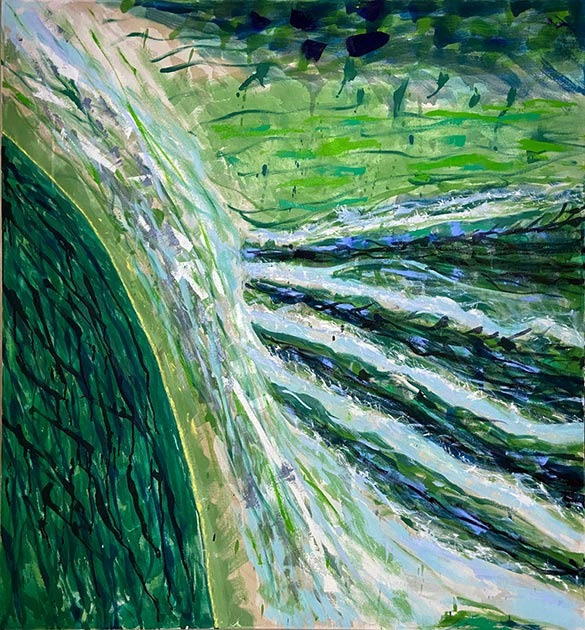
CBP: Your most recent works on canvas, that also form part of Hortus Fabulus are inspired by reading, whilst on Skye, TJ Clark’s book ‘If These Apples Should Fall’, an analysis of Cezanne. These paintings too contain sinewy root like gestures with more of a feel for vistas. They allude to varying perspectives, scale and cropping in their composition, from ariel to subterranean views. Can you talk about how this work evolved and the relationship between their intuitive making and location and text as inspiration?
DM: Well Clark’s reference was to Monet’s garden where he deemed it a Hortus Conclusus. It struck a chord as I was at the time sitting looking out at an ‘enclosed garden’ carved out of the wildness of the Trotternish Ridge on Skye. The first of the series draws on my memories of that place and has led into further reminisces of gardens in Cornwall, East Anglia & Italy as well as readings about others such as Horace’s Sabine Farm and its Bandusian Spring that I’ve yet to visit so my memories in that case are simply photographs and film. So the tangle of mark marking is both my instinctive reaction to the canvas in front of me and to memories of being in the locations I’m recalling.
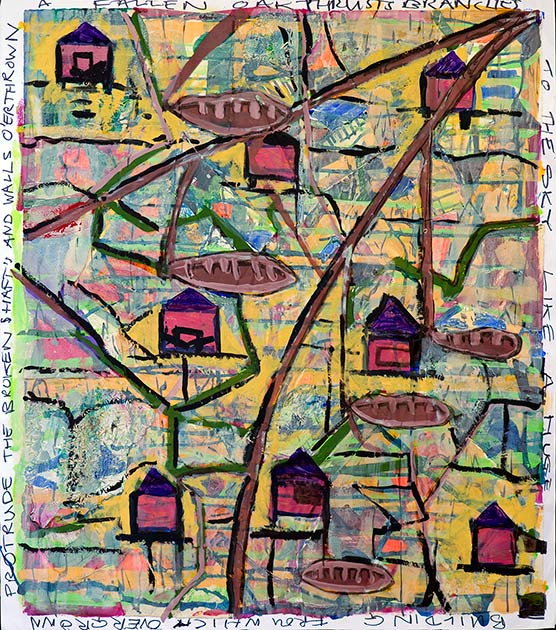
CBP: During the studio visit you talked about the importance of literature as inspiration, including Simon Schama’s ‘Landscape and Memory, a factual text of landscape and human histories connected with it. You produced a series of large square works on paper Landscapes and Memories framed with quotes from this book around their border. How did this book influence the development of these works?
DM: That series was a result of redeployment of material. I hate throwing stuff away so often tear up failed works on paper and collage them to make new pieces. As these developed I knew they needed some kind of synthesising idea. The Schama book was being reread many years on from my initial purchase of it and its form, discussing Landscape through three headings; Wood, Water and Rock, had many rich associative connotations and quotations that I felt might act as both a jumping off point for each panel as well as act as a framing device. So I began matching quotations to the evolving abstractions and refiguring line, form and colour to ‘fit’ the texts. I’ve always envisaged the 54 works (18 in each group) being shown together but so far only the Wood group has been shown in my old studios in Harrington Mill, Long Eaton back in 2016.
Reflecting on the influence of literature on my painting is really hard for me to answer. I read a lot and reflect a lot on that reading but I can’t say how that feeds into the work other than, of course, that much of it reappears in certain projects as direct quotation and as a framing device. In fact looking back a textual element has often spurred me into action even where it never manifests itself in the finished work.
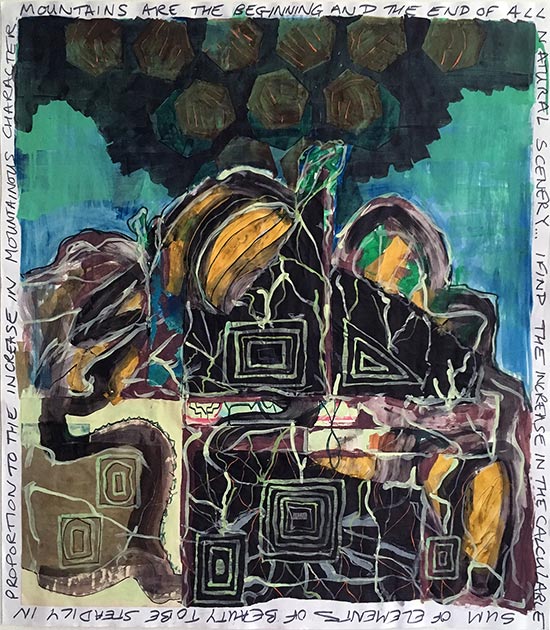
CBP: The scale and structure of Landscape and Memories, allude to abstractions of folded out maps. You also showed me a very early study of a coloured in map and talked about your fascination as a young artist for doodling on them. How have maps influenced the compositional strategies and ideas in your practice?
DM: Sean Scully was once quoted as saying the way paint naturally moved had ‘something of the nature of nature’. The way in which roads, contour lines etc. navigate the landscapes is very similar and has always fascinated me. I began colouring in maps in a fairly casual and haphazard manner as a teenager and have been doing it ever since; my sketchbooks are littered with them. So I guess those resulting lines and forms have wormed their way into my head long since!
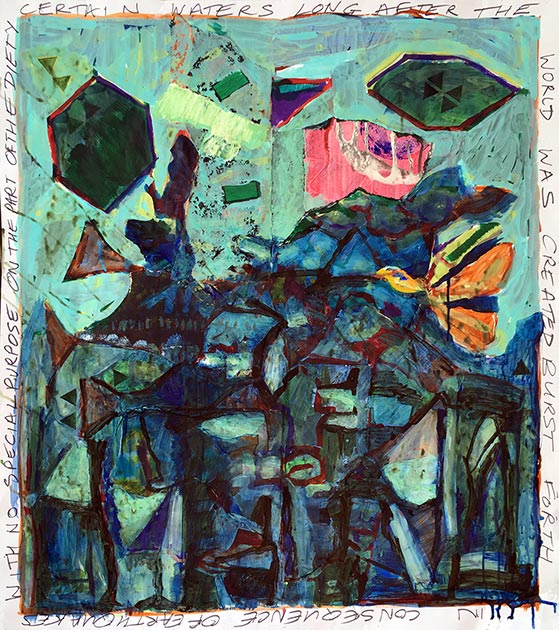
CBP: You are also working on an ongoing series of small same size works based on touring around regional villages The Heart Of Rural England. They allude to a representation of these places with diverse imagery and compositional devices. They bear the influence of photographic documentation too. Can you say something about the essence of what you are aiming for with them? Do you find particular puzzles to solve in the making?
DM: These have been in process, on and off, since September 2010 and now amount to over 150 small (30cm x 40cm) oils. I visit each village (across Leicestershire) taking snaps whilst wandering about and then digitally ‘collage’ bits from them that form the basis of the composition. When I started I was aiming at a singular response to each location but I suspect that’s become a lot harder over all that time. Oddly enough although I think there’s nothing recognisable, one to twice, people have commented that they know where the place is, so maybe I’m more transparent that I’d care to believe. I imagine that the passage of time, interrupted by COVID of course has had an impact on the way they have evolved. I showed the first set of all the listed places in my own District (NW Leics) back in 2011 in a show titled From The Earth Wealth (after the district motto) at Castle Donington’s Tarpey Gallery I’ve yet to exhibit the following three district sets, Charnwood, Melton & Harborough and yet to undertake the remaining three or the city itself. Whether the 300 plus works that will comprise the whole will ever be shown together is doubtful!
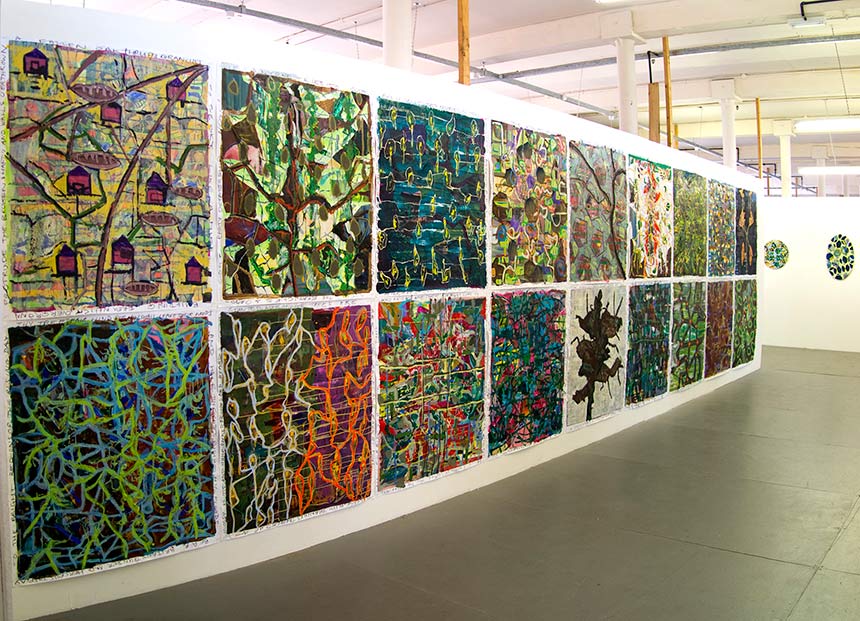
CBP: You briefly mentioned music when I visited, and I couldn’t help noticing a comprehensive vinyl collection. What types of music influences your painting? Do you play it whilst working, or paint with an ear worm in silence?
DM: Jazz is another passion that I don’t think I raised at all. Perhaps the idea of a melody and key structure and the way in which a jazz player takes it and improvises could be part of mark making/meaning conundrum – I once gave a short talk at a show by two friends that focused on Mondrian’s love of jazz that mused on whether – and how – that manifested itself in painting with such seeing constraints.
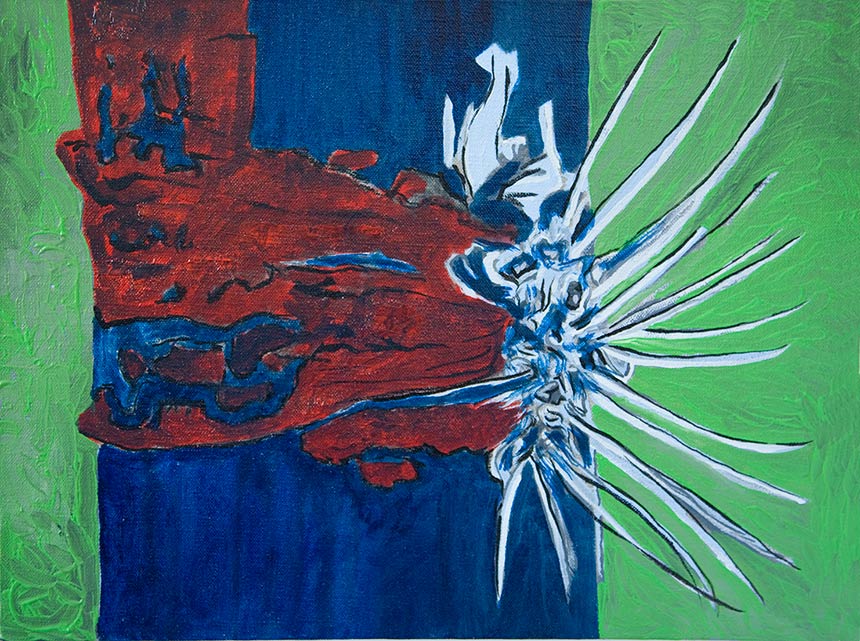
CBP: Can you discuss more generally the process of painting and the relationship between intuitive mark making, layering and the definition of form in your work?
DM: Characterising what I do – and I doubt I’m the only one – as a deliberative process is a bit of a stretch to be honest. Many years back I had a very clear idea of how and what was going to happen when I set off making a piece but somewhere down the line I decided, perhaps erroneously, to go full on into intuition, so idea and action are intermingled. As another painter I much admire – Thomas Nozkowski – said a few years back “I don’t know if this really means too much… its part of an effort to keep myself honest and to make sure painting’s really are whole and not pieces of whole”.
And a quote that always strikes a chord, ‘Authentic art has no use for proclamations, it accomplishes its work in silence’ Marcel Proust.
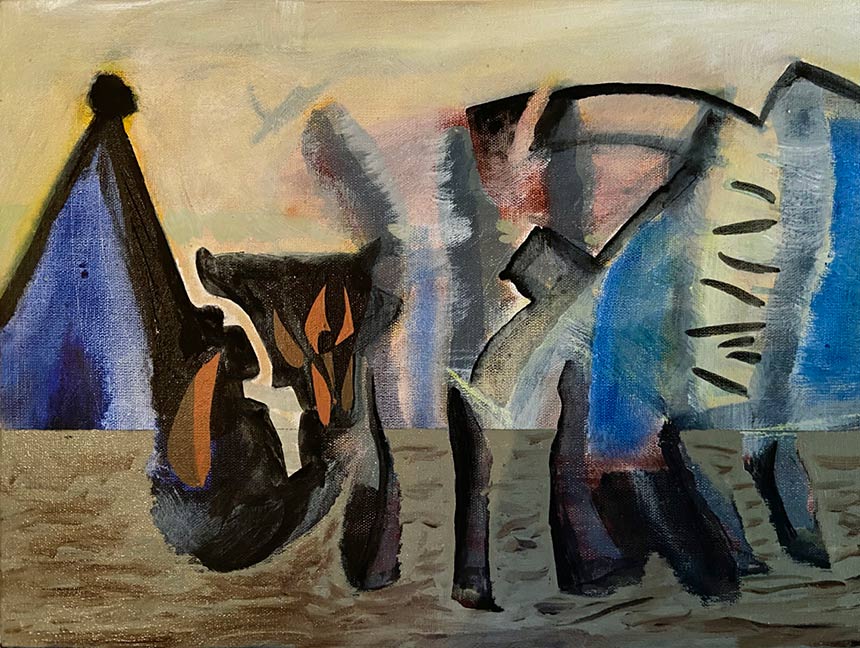
CBP: Describe a typical painting day and your movement between the different areas in your home studio.
DM: As we’ve discovered in this chat my various projects reveal my haphazard approach to pretty much everything! And as I get older this seems to be gathering pace alongside the reducing commitments to other activities. In fact other than looking after the dog and supporting the Brisons Veor Trust (an artists residency project on Cape Cornwall that I currently chair) I’m fortunate to be able to spend most days moving between the workshop, the two studios (for messy stuff and drawing) and the living space. Hence the ridiculous amount of stuff that gets made and reading that gets done.
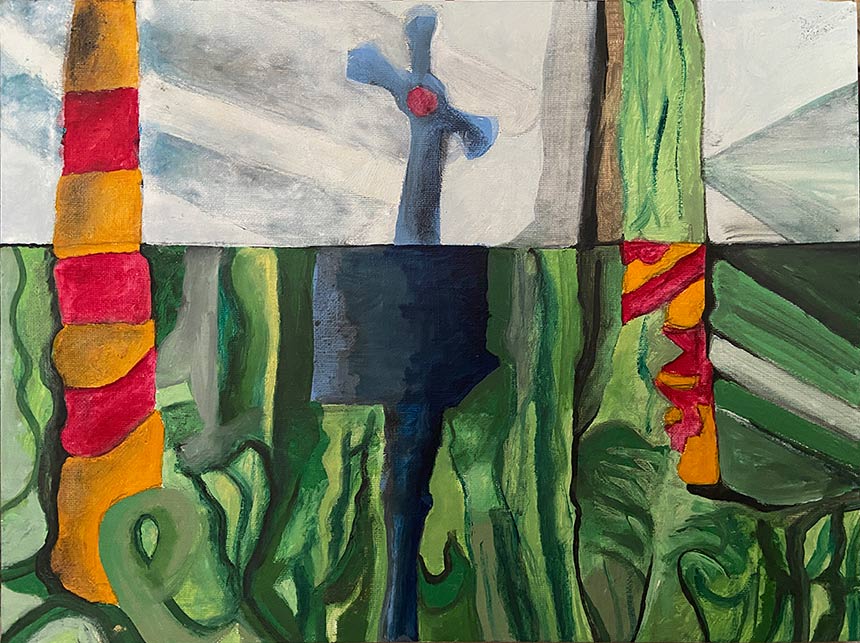
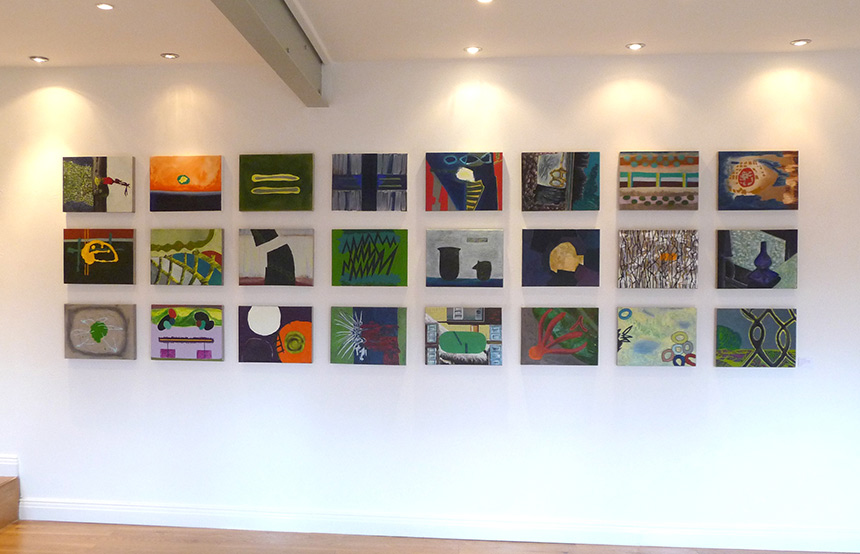
David Manley attended Art School in Exeter, Falmouth, and Birmingham before taking up a Fellowship at Cheltenham Art School in 1975. His career includes exhibitions in Italy, Portugal and Japan as well as across the UK. More recently his solo shows have included Derby Museum & Art Gallery and the Angear Gallery at Nottingham University’s Lakeside Arts Centre. He worked in Arts Administration and Higher Education, latterly as Dean of Art & Design at Derby University.
https://davidmanley.wordpress.com
Instagram @profdavid
